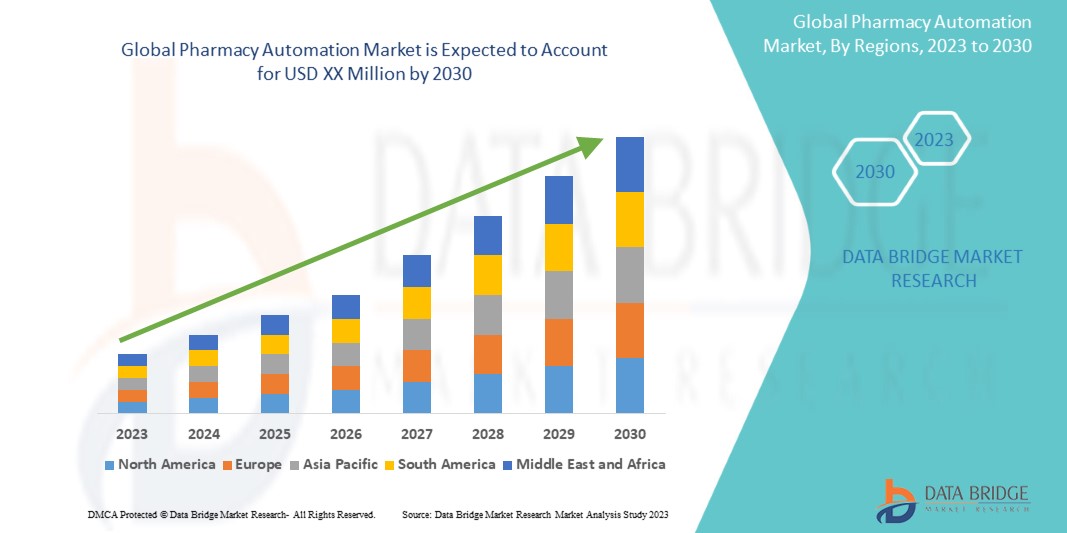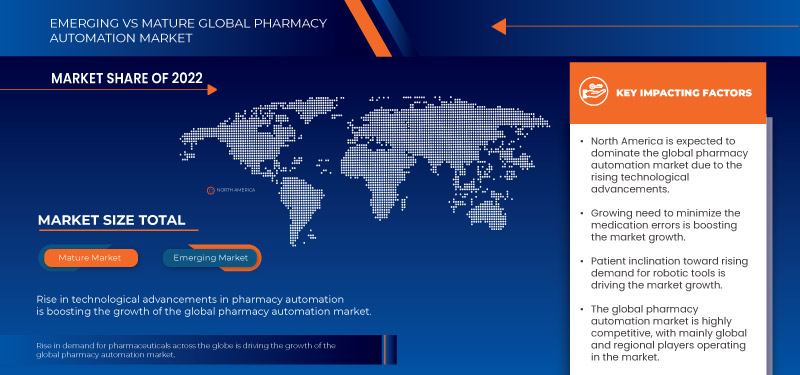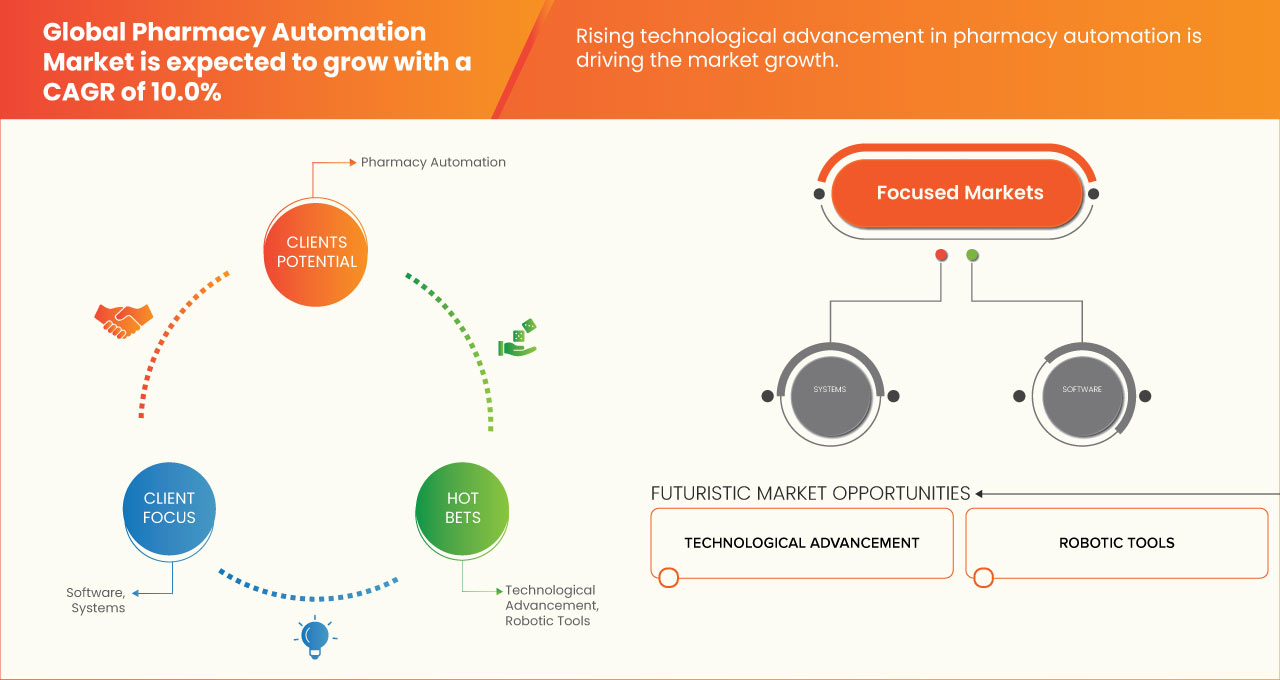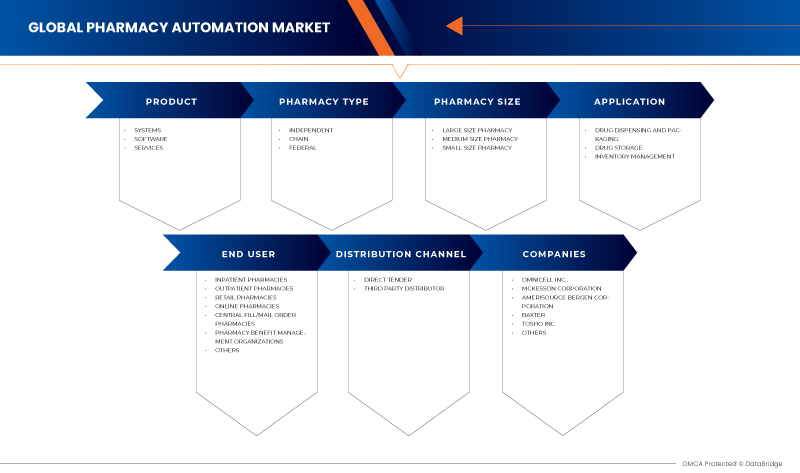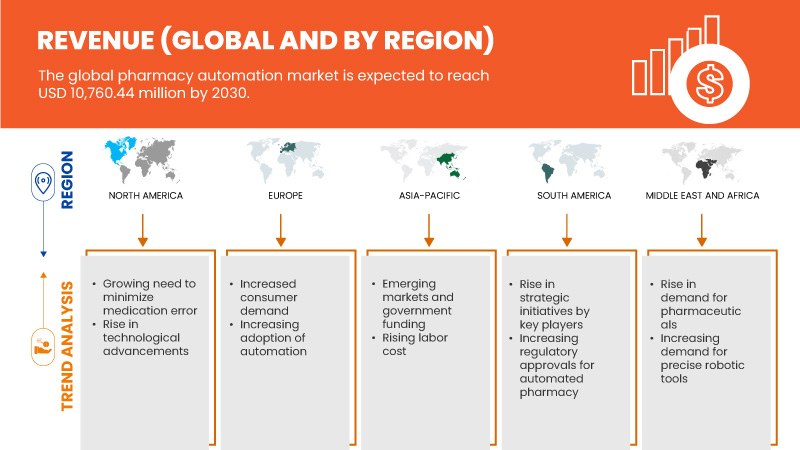>Mercado global de automatización de farmacias, por producto (sistemas, software y servicios), tipo de farmacia (independiente, cadena y federal), tamaño de farmacia (farmacia de tamaño grande, farmacia de tamaño mediano y farmacia de tamaño pequeño), aplicación (dispensación y envasado de medicamentos, almacenamiento de medicamentos y gestión de inventario), usuario final (farmacias para pacientes hospitalizados, farmacias para pacientes ambulatorios, farmacias minoristas, farmacias en línea, farmacias de llenado central/pedido por correo, organizaciones de gestión de beneficios farmacéuticos y otras), canal de distribución (licitación directa y distribuidor externo) - Tendencias de la industria y pronóstico hasta 2030.
Análisis y perspectivas del mercado de automatización de farmacias
La creciente incidencia de accidentes y muertes debido a errores en la prescripción de medicamentos ejerce una enorme presión sobre el sector sanitario en general. Tanto los profesionales sanitarios como los farmacéuticos buscan soluciones más eficaces y precisas para evitar estos frecuentes fallos médicos. Además, con el aumento del número de pacientes y visitantes y sus respectivas necesidades de seguridad, el sistema de suministro de medicamentos se vuelve cada día más complicado. Para abordar este grave problema, las tecnologías avanzadas, como los sistemas de automatización de farmacias, están surgiendo como las herramientas más poderosas. El objetivo de estos instrumentos es reducir los errores en las prescripciones médicas y maximizar la seguridad del paciente. Por lo tanto, la implementación de estos sistemas de automatización de farmacias ayuda a los proveedores de servicios sanitarios y a los farmacéuticos a minimizar sus pérdidas y mejorar la calidad y la productividad.
Además, la implementación de innovaciones tecnológicas y el avance de los sistemas automatizados con sistemas de automatización de farmacias mejorados conducen a mayores tasas de éxito y nuevas aplicaciones de dispositivos con mayor demanda de productos innovadores para medicamentos recetados para la preparación, dispensación, almacenamiento y etiquetado que están impulsando el crecimiento del mercado durante el período de pronóstico. Sin embargo, se anticipa que factores como la renuencia a implementar sistemas de automatización de farmacias debido a su alto costo restringirían su adopción, lo que se espera que frene el crecimiento del mercado.
El mercado mundial de automatización de farmacias es favorable y tiene como objetivo reducir los errores de dispensación de medicamentos y mejorar la seguridad del paciente. Data Bridge Market Research analiza que el mercado mundial de automatización de farmacias crecerá a una tasa compuesta anual del 10,0 % durante el período de pronóstico de 2023 a 2030.
|
Métrica del informe |
Detalles |
|
Período de pronóstico |
2023 a 2030 |
|
Año base |
2022 |
|
Año histórico |
2021 (Personalizable para 2015 - 2020) |
|
Unidades cuantitativas |
Ingresos en millones y precios en USD |
|
Segmentos cubiertos |
Product (Systems, Software, and Services), Pharmacy Type (Independent, Chain, and Federal), Pharmacy Size (Large Size Pharmacy, Medium Size Pharmacy, and Small Size Pharmacy), Application (Drug Dispensing and Packaging, Drug Storage, and Inventory Management), End User (Inpatient Pharmacies, Outpatient Pharmacies, Retail Pharmacies, Online Pharmacies, Central Fill/Mail Order Pharmacies, Pharmacy Benefit Management Organizations, and Others), Distribution Channel (Direct Tender and Third Party Distributor) |
|
Countries Covered |
U.S., Canada, Mexico, Germany, France, Italy, U.K., Spain, Netherlands, Russia, Switzerland, Turkey, Belgium, rest of Europe, Japan, China, India, South Korea, Australia, Singapore, Malaysia, Thailand, Indonesia, Philippines, rest of Asia-Pacific, Brazil, Argentina, rest of South America, Saudi Arabia, South Africa, U.A.E., Israel, Egypt, and rest of Middle East and Africa |
|
Market Players Covered |
ARxIUM, OMNICELL INC., Cerner Corporation, Capsa Healthcare, ScriptPro LLC, RxSafe, LLC., MedAvail Technologies, Inc., Asteres Inc., InterLink AI, Inc., BD, Baxter, Fullscript, McKesson Corporation, Innovation Associates, AmerisourceBergen Corporation, UNIVERSAL LOGISTICS HOLDINGS, INC, Takazono Corporation, TOSHO Inc., Willach Group, BIQHS, Synergy Medical, Yuyama, APD Algoritmos Procesos y Diseños S.A, JVM Europe BV, Genesis Automation LTD, myPak Solutions Pty Ltd., Demodeks Pharmacy Shelving, Deenova S.r.l., KUKA AG, and KLS Pharma Robotics GmbH among others |
Market Definition
Pharmacy automation plays a significant role in modern healthcare as it allows medicine to be conveniently delivered and distributed in the hospital pharmacy or retail pharmacy. Automation of the pharmacy helps to reduce the error in the medication. It prevents errors such as missing medication information, missing patient information, dispensing formulations, prescription errors, tracking therapy, and others that can occur during the manual process. One of the most common types of errors is incorrect labeling information and instructions. To improve healthcare facilities and services and to ensure patient safety, it is vital to reduce prescription error, which is why the pharmacy automation system is used in quite important ways to eliminate storage, inventory, usage, and retrieval error. The use of pharmacy automation is highly acceptable and beneficial in increasing the efficiency and accuracy of pharmacies. Furthermore, the need for preventing medication errors and the rising geriatric population across the globe are likely to boost the market growth in the forecast period.
Global Pharmacy Automation Market Dynamics
This section deals with understanding the market drivers, advantages, opportunities, restraints, and challenges. All of this is discussed in detail below:
DRIVERS
- Growing Need to Minimize Medication Errors
Medical errors are the leading cause of death in countries, further leading to increased hospitalization worldwide. Medication errors are of various types that include errors in the chain of pharmacological and pharmaceutical patient care: prescription errors, dispensing errors, administration errors, transcription errors, prescribing faults, and ‘across settings’ errors.
A medication mistake can occur due to a number of variables, such as inadequate order coordination between the doctor and pharmacist, improper storage practices in pharmacies, and misunderstandings arising from the use of identical labels.
Dispensing errors include any anomalies or deviations from the prescribing order, such as dispensing the wrong dose, drug, dosage type, incorrect amount, or insufficient, incorrect, or inadequate labeling. The misleading or insufficient instruction for use, improper planning, packaging, or storage of medication before dispensing is also considered a medication error.
In a pharmacy that fills 250 prescriptions per day, errors occur at a rate of 4 per day, amounting to an estimated 51.5 million errors out of 3 billion prescriptions filled annually across the nation.
- Rising Demand for Pharmaceuticals
The escalating demand for pharmaceuticals is observed across the globe due to the surging incidence of chronic diseases such as cancers, diabetes, obesity, and asthma among others. The people suffering from these diseases are dependent on one or the other medication prescribed to them by their physicians.
Also, the aging population is increasing globally due to the availability of better healthcare facilities. Increased research and development leading to the launch of effective and novel medications oriented to specific diseases further aids in the surging demand for pharmaceuticals.
Moreover, the emergence of COVID-19 also has increased the demand for various medications worldwide which include vitamin-C tablets and hydroxychloroquine, among others leading to a significant rise in the demand for pharmaceuticals.
OPPORTUNITY
- Need for Increasing the Efficiency of Work within the Pharmacies
Every pharmacy is trying to do the same things which include correctly and efficiently filling prescriptions, providing high-quality patient care, and maintaining a sustainable business model in which workers have good job satisfaction and consumers are satisfied.
In order to improve the effectiveness of their pharmacy activities in support of overall hospital strategies and priorities to provide high-quality patient-centered care, many hospital and pharmacy leaders have started adopting pharmacy automation systems.
The adoption of enhanced workflow and pharmacy automation software and system has potentially increased the efficiency of the pharmacies. Thereby, the need for increasing the efficiency of work within the pharmacies acts as an opportunity for market growth.
RESTRAINT
- High Capital Investment
Pharmacy automation systems are more costly as compared to manual systems. The price of an average pharmacy automation system starts at USD 59,198.45 but for more exotic versions, it can be as high as USD 591,984.50.
Since the capital investment needed for the pharmacy automation system implementation is significantly high, it makes it difficult to adopt such systems in hospitals and pharmacies in developing nations along with small pharmacies across the globe. Thus, the high capital investment leads to the decreased adoption rate of pharmacy automation systems. Hence, it acts as a restraint for market growth.
CHALLENGE
- Stringent Regulatory Procedures
Hospitals and pharmacies are required to play a crucial role in the drug supply chain of the nation: the distribution of medicines to the public. Among the several regulations — state and federal — that regulate medicine dispensing practices, there are 3 important laws relating to the protection and security of both the general public and practitioners in the industry.
These laws apply to Drug supply chain protection, controlled substance regulation and safety, and pharmaceutical hazardous waste management — and are implemented by the FDA, DEA, and EPA.
Manufacturers of automated pharmaceutical systems, therefore, have to comply with various regulations; maintaining such compliance is a tedious job and can delay product launches. Thus, the stringency of regulatory procedures acts as a challenge to market growth.
Recent Developments
- In January 2023, AmerisourceBergen Corporation announced the completion of its acquisition of PharmaLex Holding GmbH. The acquisition of PharmaLex enhances AmerisourceBergen Corporation’s growth strategy by advancing its leadership in specialty services and global platform of pharma manufacturer services capabilities.
- In February 2022, Baxter announced that it has received authorization from the Common Vulnerability and Exposures (CVE) program to be a CVE Numbering Authority.
Global Pharmacy Automation Market
The global pharmacy automation market is segmented into six notable segments based on product, pharmacy type, pharmacy size, application, end user, and distribution channel.
PRODUCT
- SYSTEMS
- SOFTWARE
- SERVICES
On the basis of product, the market is segmented into systems, software, and services.
PHARMACY TYPE
- INDEPENDENT
- CHAIN
- FEDERAL
On the basis of pharmacy type, the market is segmented into independent, chain, and federal.
PHARMACY SIZE
- LARGE SIZE PHARMACY
- MEDIUM SIZE PHARMACY
- SMALL SIZE PHARMACY
On the basis of pharmacy size, the market is segmented into large size pharmacy, medium size pharmacy, and small size pharmacy.
APPLICATION
- DRUG DISPENSING AND PACKAGING
- DRUG STORAGE
- INVENTORY MANAGEMENT
On the basis of application, the market is segmented into drug dispensing and packaging, drug storage, and inventory management.
END USER
- INPATIENT PHARMACIES
- OUTPATIENT PHARMACIES
- RETAIL PHARMACIES
- ONLINE PHARMACIES
- CENTRAL FILL/MAIL ORDER PHARMACIES
- PHARMACY BENEFIT MANAGEMENT ORGANIZATIONS
- OTHERS
On the basis of end user, the market is segmented into inpatient pharmacies, outpatient pharmacies, retail pharmacies, online pharmacies, central fill/mail order pharmacies, pharmacy benefit management organizations, and others.
DISTRIBUTION CHANNEL
- DIRECT TENDER
- THIRD PARTY DISTRIBUTOR
On the basis of distribution channel, the market is segmented into direct tender and third party distributor.
Global Pharmacy Automation Market Regional Analysis/Insights
The global pharmacy automation market is segmented into six notable segments based on product, pharmacy type, pharmacy size, application, end user, and distribution channel.
The countries covered in this market report are U.S., Canada, Mexico, Germany, France, Italy, U.K., Spain, Netherlands, Russia, Switzerland, Turkey, Belgium, rest of Europe, Japan, China, India, South Korea, Australia, Singapore, Malaysia, Thailand, Indonesia, Philippines, rest of Asia-Pacific, Brazil, Argentina, rest of South America, Saudi Arabia, South Africa, U.A.E., Israel, Egypt, and rest of Middle East and Africa.
Asia-Pacific is dominating the market due to the increasing investment in R&D, which is expected to boost market growth. In 2023, China is expected to dominate the Asia-Pacific region due to the growing need to minimize medication errors and the rising demand for pharmaceuticals. The U.S. is expected to dominate the North America region due to the strong presence of key players such as OMNICELL, INC., McKesson Corporation, and AmerisourceBergen Corporation. Germany is expected to dominate the Europe region due to increasing awareness regarding the advantages of pharmacy automation systems over manual methods.
The country section of the report also provides individual market-impacting factors and changes in regulation in the market domestically that impact the current and future trends of the market. Data points such as new sales, replacement sales, country demographics, regulatory acts, and import-export tariffs are some of the major pointers used to forecast the market scenario for individual countries. Also, the presence and availability of global brands and their challenges faced due to large or scarce competition from local and domestic brands, and the impact of sales channels are considered while providing forecast analysis of the country data.
Competitive Landscape and Global Pharmacy Automation Market Share Analysis
The global pharmacy automation market competitive landscape provides details of competitors. Details included are company overview, company financials, revenue generated, market potential, investment in R&D, new market initiatives, global presence, production sites and facilities, production capacities, company strengths and weaknesses, product launch, product width and breadth, and application dominance. The above data points provided are only related to the companies' focus on the market.
Algunos de los principales actores del mercado que operan en el mercado global de automatización de farmacias son ARxIUM, OMNICELL INC., Cerner Corporation, Capsa Healthcare, ScriptPro LLC, RxSafe, LLC., MedAvail Technologies, Inc., Asteres Inc., InterLink AI, Inc., BD, Baxter, Fullscript, McKesson Corporation, Innovation Associates, AmerisourceBergen Corporation, UNIVERSAL LOGISTICS HOLDINGS, INC, Takazono Corporation, TOSHO Inc., Willach Group, BIQHS.
SKU-
Obtenga acceso en línea al informe sobre la primera nube de inteligencia de mercado del mundo
- Panel de análisis de datos interactivo
- Panel de análisis de empresas para oportunidades con alto potencial de crecimiento
- Acceso de analista de investigación para personalización y consultas
- Análisis de la competencia con panel interactivo
- Últimas noticias, actualizaciones y análisis de tendencias
- Aproveche el poder del análisis de referencia para un seguimiento integral de la competencia
Tabla de contenido
1 INTRODUCTION
1.1 OBJECTIVES OF THE STUDY
1.2 MARKET DEFINITION
1.3 OVERVIEW OF GLOBAL PHARMACY AUTOMATION MARKET
1.4 CURRENCY AND PRICING
1.5 LIMITATIONS
1.6 MARKETS COVERED
2 MARKET SEGMENTATION
2.1 MARKETS COVERED
2.2 GEOGRAPHICAL SCOPE
2.3 YEARS CONSIDERED FOR THE STUDY
2.4 DBMR TRIPOD DATA VALIDATION MODEL
2.5 PRIMARY INTERVIEWS WITH KEY OPINION LEADERS
2.6 MULTIVARIATE MODELLING
2.7 MARKET APPLICATION COVERAGE GRID
2.8 PRODUCT LIFELINE CURVE
2.9 DBMR MARKET POSITION GRID
2.1 VENDOR SHARE ANALYSIS
2.11 SECONDARY SOURCES
2.12 ASSUMPTIONS
3 EXECUTIVE SUMMARY
4 GLOBAL PHARMACY AUTOMATION MARKET: REGULATIONS
4.1 EXISTING STATE LAWS AND REGULATIONS FOR THE USE OF AUTOMATED DISPENSING SYSTEMS (ADS) IN THE U.S.
5 MARKET OVERVIEW
5.1 DRIVERS
5.1.1 GROWING NEED TO MINIMIZE MEDICATION ERRORS
5.1.2 RISING DEMAND FOR PHARMACEUTICALS
5.1.3 RISING LABOR COST
5.1.4 ADVANTAGES OF PHARMACY AUTOMATION SYSTEMS OVER MANUAL METHODS
5.1.5 TECHNOLOGICAL ADVANCEMENTS AND PRECISE ROBOTIC TOOLS
5.2 RESTRAINTS
5.2.1 RELUCTANCE AMONG THE HEALTHCARE ORGANIZATIONS TO ADOPT PHARMACY AUTOMATION SYSTEMS
5.2.2 HIGH CAPITAL INVESTMENT
5.2.3 INTEROPERABILITY PROBLEMS IN PHARMACY AUTOMATION
5.3 OPPORTUNITIES
5.3.1 NEED FOR INCREASING THE EFFICIENCY OF WORK WITHIN THE PHARMACIES
5.3.2 RISING HEALTHCARE EXPENDITURE IN EMERGING NATIONS
5.3.3 STRATEGIC INITIATIVES OF KEY MARKET PLAYERS
5.4 CHALLENGES
5.4.1 STRINGENCY OF REGULATORY PROCEDURES
5.4.2 SKILLED WORK-FORCE CHALLENGES
5.4.3 LIMITATIONS OF PHARMACY AUTOMATION SYSTEMS
6 GLOBAL PHARMACY AUTOMATION MARKET, BY PRODUCT
6.1 OVERVIEW
6.2 SYSTEMS
6.3 SOFTWARE
6.4 SERVICES
7 GLOBAL PHARMACY AUTOMATION MARKET, BY PHARMACY TYPE
7.1 OVERVIEW
7.2 INDEPENDENT
7.3 CHAIN
7.4 FEDERAL
8 GLOBAL PHARMACY AUTOMATION MARKET, BY PHARMACY SIZE
8.1 OVERVIEW
8.2 LARGE SIZE PHARMACY
8.3 MEDIUM SIZE PHARMACY
8.4 SMALL SIZE PHARMACY
9 GLOBAL PHARMACY AUTOMATION MARKET, BY APPLICATION
9.1 OVERVIEW
9.2 DRUG DISPENSING AND PACKAGING
9.3 DRUG STORAGE
9.4 INVENTORY MANAGEMENT
10 GLOBAL PHARMACY AUTOMATION MARKET, BY END USER
10.1 OVERVIEW
10.2 INPATIENT PHARMACIES
10.3 OUTPATIENT PHARMACIES
10.4 RETAIL PHARMACIES
10.5 ONLINE PHARMACIES
10.6 CENTRAL FILL/MAIL ORDER PHARMACIES
10.7 PHARMACY BENEFIT MANAGEMENT ORGANIZATIONS
10.8 OTHERS
11 GLOBAL PHARMACY AUTOMATION MARKET, BY DISTRIBUTION CHANNEL
11.1 OVERVIEW
11.2 DIRECT TENDER
11.3 THIRD PARTY DISTRIBUTOR
12 GLOBAL PHARMACY AUTOMATION MARKET, BY REGION
12.1 OVERVIEW
12.2 NORTH AMERICA
12.2.1 U.S.
12.2.2 CANADA
12.2.3 MEXICO
12.3 EUROPE
12.3.1 GERMANY
12.3.2 FRANCE
12.3.3 ITALY
12.3.4 U.K.
12.3.5 SPAIN
12.3.6 SWITZERLAND
12.3.7 RUSSIA
12.3.8 NETHERLANDS
12.3.9 BELGIUM
12.3.10 TURKEY
12.3.11 REST OF EUROPE
12.4 ASIA-PACIFIC
12.4.1 JAPAN
12.4.2 CHINA
12.4.3 AUSTRALIA
12.4.4 SOUTH KOREA
12.4.5 INDIA
12.4.6 SINGAPORE
12.4.7 THAILAND
12.4.8 INDONESIA
12.4.9 MALAYSIA
12.4.10 PHILIPPINES
12.4.11 REST OF ASIA-PACIFIC
12.5 SOUTH AMERICA
12.5.1 BRAZIL
12.5.2 ARGENTINA
12.5.3 REST OF SOUTH AMERICA
12.6 MIDDLE EAST & AFRICA
12.6.1 SAUDI ARABIA
12.6.2 SOUTH AFRICA
12.6.3 U.A.E.
12.6.4 ISRAEL
12.6.5 EGYPT
12.6.6 REST OF MIDDLE EAST & AFRICA
13 GLOBAL PHARMACY AUTOMATION MARKET, COMPANY LANDSCAPE
13.1 COMPANY SHARE ANALYSIS: GLOBAL
13.2 COMPANY SHARE ANALYSIS: NORTH AMERICA
13.3 COMPANY SHARE ANALYSIS: EUROPE
13.4 COMPANY SHARE ANALYSIS: ASIA-PACIFIC
14 SWOT ANALYSIS
15 COMPANY PROFILE
15.1 OMNICELL, INC.
15.1.1 COMPANY SNAPSHOT
15.1.2 REVENUE ANALYSIS
15.1.3 COMPANY SHARE ANALYSIS
15.1.4 PRODUCT PORTFOLIO
15.1.5 RECENT DEVELOPMENTS
15.2 MCKESSON CORPORATION
15.2.1 COMPANY SNAPSHOT
15.2.2 REVENUE ANALYSIS
15.2.3 COMPANY SHARE ANALYSIS
15.2.4 PRODUCT PORTFOLIO
15.2.5 RECENT DEVELOPMENTS
15.3 AMERISOURCEBERGEN CORPORATION
15.3.1 COMPANY SNAPSHOT
15.3.2 REVENUE ANALYSIS
15.3.3 COMPANY SHARE ANALYSIS
15.3.4 PRODUCT PORTFOLIO
15.3.5 RECENT DEVELOPMENTS
15.4 BAXTER
15.4.1 COMPANY SNAPSHOT
15.4.2 REVENUE ANALYSIS
15.4.3 COMPANY SHARE ANALYSIS
15.4.4 PRODUCT PORTFOLIO
15.4.5 RECENT DEVELOPMENTS
15.5 TOSHO CO., INC.
15.5.1 COMPANY SNAPSHOT
15.5.2 COMPANY SHARE ANALYSIS
15.5.3 PRODUCT PORTFOLIO
15.5.4 RECENT DEVELOPMENTS
15.6 APD ALGORITMOS PROCESOS Y DISEÑOS S.A.
15.6.1 COMPANY SNAPSHOT
15.6.2 PRODUCT PORTFOLIO
15.6.3 RECENT DEVELOPMENTS
15.7 ASTERES INC.
15.7.1 COMPANY SNAPSHOT
15.7.2 PRODUCT PORTFOLIO
15.7.3 RECENT DEVELOPMENTS
15.8 ARXIUM
15.8.1 COMPANY SNAPSHOT
15.8.2 PRODUCT PORTFOLIO
15.8.3 RECENT DEVELOPMENTS
15.9 BD
15.9.1 COMPANY SNAPSHOT
15.9.2 REVENUE ANALYSIS
15.9.3 COMPANY SHARE ANALYSIS
15.9.4 PRODUCT PORTFOLIO
15.9.5 RECENT DEVELOPMENTS
15.1 BIQHS
15.10.1 COMPANY SNAPSHOT
15.10.2 PRODUCT PORTFOLIO
15.10.3 RECENT DEVELOPMENTS
15.11 CAPSA HEALTHCARE
15.11.1 COMPANY SNAPSHOT
15.11.2 PRODUCT PORTFOLIO
15.11.3 RECENT DEVELOPMENTS
15.12 CERNER CORPORATION
15.12.1 COMPANY SNAPSHOT
15.12.2 REVENUE ANALYSIS
15.12.3 PRODUCT PORTFOLIO
15.12.4 RECENT DEVELOPMENTS
15.13 DEENOVA S.R.L.
15.13.1 COMPANY SNAPSHOT
15.13.2 PRODUCT PORTFOLIO
15.13.3 RECENT DEVELOPMENTS
15.14 DEMODEKS PHARMACY SHELVING
15.14.1 COMPANY SNAPSHOT
15.14.2 PRODUCT PORTFOLIO
15.14.3 RECENT DEVELOPMENTS
15.15 FULLSCRIPT
15.15.1 COMPANY SNAPSHOT
15.15.2 PRODUCT PORTFOLIO
15.15.3 RECENT DEVELOPMENTS
15.16 GENESIS AUTOMATION LTD
15.16.1 COMPANY SNAPSHOT
15.16.2 PRODUCT PORTFOLIO
15.16.3 RECENT DEVELOPMENTS
15.17 IA
15.17.1 COMPANY SNAPSHOT
15.17.2 PRODUCT PORTFOLIO
15.17.3 RECENT DEVELOPMENTS
15.18 INTERLINK AI, INC
15.18.1 COMPANY SNAPSHOT
15.18.2 PRODUCT PORTFOLIO
15.18.3 RECENT DEVELOPMENTS
15.19 JVM EUROPE BV
15.19.1 COMPANY SNAPSHOT
15.19.2 PRODUCT PORTFOLIO
15.19.3 RECENT DEVELOPMENTS
15.2 KLS PHARMA ROBOTICS GMBH
15.20.1 COMPANY SNAPSHOT
15.20.2 PRODUCT PORTFOLIO
15.20.3 RECENT DEVELOPMENTS
15.21 KUKA AG
15.21.1 COMPANY SNAPSHOT
15.21.2 REVENUE ANALYSIS
15.21.3 COMPANY SHARE ANALYSIS
15.21.4 PRODUCT PORTFOLIO
15.21.5 RECENT DEVELOPMENTS
15.22 MEDAVAIL TECHNOLOGIES, INC.
15.22.1 COMPANY SNAPSHOT
15.22.2 PRODUCT PORTFOLIO
15.22.3 RECENT DEVELOPMENTS
15.23 MYPAK SOLUTIONS PTY LTD.
15.23.1 COMPANY SNAPSHOT
15.23.2 PRODUCT PORTFOLIO
15.23.3 RECENT DEVELOPMENTS
15.24 RXSAFE, LLC.
15.24.1 COMPANY SNAPSHOT
15.24.2 PRODUCT PORTFOLIO
15.24.3 RECENT DEVELOPMENTS
15.25 SCRIPTPRO LLC
15.25.1 COMPANY SNAPSHOT
15.25.2 COMPANY SHARE ANALYSIS
15.26.3 PRODUCT PORTFOLIO
15.26.4 RECENT DEVELOPMENTS
15.27 SYNERGY MEDICAL
15.27.1 COMPANY SNAPSHOT
15.27.2 PRODUCT PORTFOLIO
15.27.3 RECENT DEVELOPMENTS
15.28 TAKAZONO CORPORATION
15.28.1 COMPANY SNAPSHOT
15.28.2 PRODUCT PORTFOLIO
15.28.3 RECENT DEVELOPMENTS
15.29 UNIVERSAL LOGISTICS HOLDINGS, INC.
15.29.1 COMPANY SNAPSHOT
15.29.2 REVENUE ANALYSIS
15.29.3 PRODUCT PORTFOLIO
15.29.4 RECENT DEVELOPMENTS
15.3 WILLACH GROUP
15.30.1 COMPANY SNAPSHOT
15.30.2 PRODUCT PORTFOLIO
15.30.3 RECENT DEVELOPMENTS
15.31 YUYAMA
15.31.1 COMPANY SNAPSHOT
15.31.2 PRODUCT PORTFOLIO
15.31.3 RECENT DEVELOPMENTS
16 QUESTIONNAIRE
17 RELATED REPORTS
Lista de figuras
FIGURE 1 GLOBAL PHARMACY AUTOMATION MARKET: SEGMENTATION
FIGURE 2 GLOBAL PHARMACY AUTOMATION MARKET: DATA TRIANGULATION
FIGURE 3 GLOBAL PHARMACY AUTOMATION MARKET: DROC ANALYSIS
FIGURE 4 GLOBAL PHARMACY AUTOMATION MARKET: GLOBAL VS REGIONAL MARKET ANALYSIS
FIGURE 5 GLOBAL PHARMACY AUTOMATION MARKET: COMPANY RESEARCH ANALYSIS
FIGURE 6 GLOBAL PHARMACY AUTOMATION MARKET: INTERVIEW DEMOGRAPHICS
FIGURE 7 GLOBAL PHARMACY AUTOMATION MARKET: MARKET APPLICATION COVERAGE GRID
FIGURE 8 GLOBAL PHARMACY AUTOMATION MARKET: DBMR MARKET POSITION GRID
FIGURE 9 GLOBAL PHARMACY AUTOMATION MARKET: VENDOR SHARE ANALYSIS
FIGURE 10 GLOBAL PHARMACY AUTOMATION MARKET: SEGMENTATION
FIGURE 11 NORTH AMERICA IS ANTICIPATED TO DOMINATE THE GLOBAL PHARMACY AUTOMATION MARKET AND ASIA-PACIFIC IS ESTIMATED TO BE GROWING WITH THE HIGHEST CAGR IN THE FORECAST PERIOD OF 2023 TO 2030
FIGURE 12 GROWING NEED TO MINIMIZE MEDICATION ERRORS IS EXPECTED TO DRIVE THE GLOBAL PHARMACY AUTOMATION MARKET IN THE FORECAST PERIOD OF 2023 TO 2030
FIGURE 13 SYSTEMS SEGMENT IS EXPECTED TO ACCOUNT FOR THE LARGEST SHARE OF THE GLOBAL PHARMACY AUTOMATION MARKET IN 2023 AND 2030
FIGURE 14 ASIA-PACIFIC IS THE FASTEST GROWING REGION FOR PHARMACY AUTOMATION MANUFACTURERS IN THE FORECAST PERIOD OF 2023 TO 2030
FIGURE 15 DRIVERS, RESTRAINTS, OPPORTUNITIES AND CHALLENGES OF GLOBAL PHARMACY AUTOMATION MARKET
FIGURE 16 GLOBAL PHARMACY AUTOMATION MARKET: BY PRODUCT, 2022
FIGURE 17 GLOBAL PHARMACY AUTOMATION MARKET: BY PRODUCT, 2023-2030 (USD
FIGURE 18 GLOBAL PHARMACY AUTOMATION MARKET: BY PRODUCT, CAGR (2023-2030)
FIGURE 19 GLOBAL PHARMACY AUTOMATION MARKET: BY PRODUCT, LIFELINE CURVE
FIGURE 20 GLOBAL PHARMACY AUTOMATION MARKET: BY PHARMACY TYPE, 2022
FIGURE 21 GLOBAL PHARMACY AUTOMATION MARKET: BY PHARMACY TYPE, 2023-2030 (USD MILLION)
FIGURE 22 GLOBAL PHARMACY AUTOMATION MARKET: BY PHARMACY TYPE, CAGR (2023-2030)
FIGURE 23 GLOBAL PHARMACY AUTOMATION MARKET: BY PHARMACY TYPE, LIFELINE CURVE
FIGURE 24 GLOBAL PHARMACY AUTOMATION MARKET: BY PHARMACY SIZE, 2022
FIGURE 25 GLOBAL PHARMACY AUTOMATION MARKET: BY PHARMACY SIZE, 2023-2030 (USD MILLION)
FIGURE 26 GLOBAL PHARMACY AUTOMATION MARKET: BY PHARMACY SIZE, CAGR (2023-2030)
FIGURE 27 GLOBAL PHARMACY AUTOMATION MARKET: BY PHARMACY SIZE, LIFELINE CURVE
FIGURE 28 GLOBAL PHARMACY AUTOMATION MARKET: BY APPLICATION, 2022
FIGURE 29 GLOBAL PHARMACY AUTOMATION MARKET: BY APPLICATION, 2023-2030 (USD MILLION)
FIGURE 30 GLOBAL PHARMACY AUTOMATION MARKET: BY APPLICATION, CAGR (2023-2030)
FIGURE 31 GLOBAL PHARMACY AUTOMATION MARKET: BY APPLICATION, LIFELINE CURVE
FIGURE 32 GLOBAL PHARMACY AUTOMATION MARKET: BY END USER, 2022
FIGURE 33 GLOBAL PHARMACY AUTOMATION MARKET: BY END USER, 2023-2030 (USD MILLION)
FIGURE 34 GLOBAL PHARMACY AUTOMATION MARKET: BY END USER, CAGR (2023-2030)
FIGURE 35 GLOBAL PHARMACY AUTOMATION MARKET: BY END USER, LIFELINE CURVE
FIGURE 36 GLOBAL PHARMACY AUTOMATION MARKET: BY DISTRIBUTION CHANNEL, 2022
FIGURE 37 GLOBAL PHARMACY AUTOMATION MARKET: BY DISTRIBUTION CHANNEL, 2023-2030 (USD MILLION)
FIGURE 38 GLOBAL PHARMACY AUTOMATION MARKET: BY DISTRIBUTION CHANNEL, CAGR (2023-2030)
FIGURE 39 GLOBAL PHARMACY AUTOMATION MARKET: BY DISTRIBUTION CHANNEL, LIFELINE CURVE
FIGURE 40 GLOBAL PHARMACY AUTOMATION MARKET: SNAPSHOT (2022)
FIGURE 41 GLOBAL PHARMACY AUTOMATION MARKET: BY REGION (2022)
FIGURE 42 GLOBAL PHARMACY AUTOMATION MARKET: BY REGION (2023 & 2030)
FIGURE 43 GLOBAL PHARMACY AUTOMATION MARKET: BY REGION (2022 & 2030)
FIGURE 44 GLOBAL PHARMACY AUTOMATION MARKET: BY PRODUCT (2023-2030)
FIGURE 45 NORTH AMERICA PHARMACY AUTOMATION MARKET: SNAPSHOT (2022)
FIGURE 46 NORTH AMERICA PHARMACY AUTOMATION MARKET: BY COUNTRY (2022)
FIGURE 47 NORTH AMERICA PHARMACY AUTOMATION MARKET: BY COUNTRY (2023 & 2030)
FIGURE 48 NORTH AMERICA PHARMACY AUTOMATION MARKET: BY COUNTRY (2022 & 2030)
FIGURE 49 NORTH AMERICA PHARMACY AUTOMATION MARKET: BY PRODUCT (2023-2030)
FIGURE 50 EUROPE PHARMACY AUTOMATION MARKET: SNAPSHOT (2022)
FIGURE 51 EUROPE PHARMACY AUTOMATION MARKET: BY COUNTRY (2022)
FIGURE 52 EUROPE PHARMACY AUTOMATION MARKET: BY COUNTRY (2023 & 2030)
FIGURE 53 EUROPE PHARMACY AUTOMATION MARKET: BY COUNTRY (2022 & 2030)
FIGURE 54 EUROPE PHARMACY AUTOMATION MARKET: BY PRODUCT (2023-2030)
FIGURE 55 ASIA-PACIFIC PHARMACY AUTOMATION MARKET: SNAPSHOT (2022)
FIGURE 56 ASIA-PACIFIC PHARMACY AUTOMATION MARKET: BY COUNTRY (2022)
FIGURE 57 ASIA-PACIFIC PHARMACY AUTOMATION MARKET: BY COUNTRY (2023 & 2030)
FIGURE 58 ASIA-PACIFIC PHARMACY AUTOMATION MARKET: BY COUNTRY (2022 & 2030)
FIGURE 59 ASIA-PACIFIC PHARMACY AUTOMATION MARKET: BY PRODUCT (2023-2030)
FIGURE 60 SOUTH AMERICA PHARMACY AUTOMATION MARKET: SNAPSHOT (2022)
FIGURE 61 SOUTH AMERICA PHARMACY AUTOMATION MARKET: BY COUNTRY (2022)
FIGURE 62 SOUTH AMERICA PHARMACY AUTOMATION MARKET: BY COUNTRY (2023 & 2030)
FIGURE 63 SOUTH AMERICA PHARMACY AUTOMATION MARKET: BY COUNTRY (2022 & 2030)
FIGURE 64 SOUTH AMERICA PHARMACY AUTOMATION MARKET: BY PRODUCT (2023-2030)
FIGURE 65 MIDDLE EAST & AFRICA PHARMACY AUTOMATION MARKET: SNAPSHOT (2022)
FIGURE 66 MIDDLE EAST & AFRICA PHARMACY AUTOMATION MARKET: BY COUNTRY (2022)
FIGURE 67 MIDDLE EAST & AFRICA PHARMACY AUTOMATION MARKET: BY COUNTRY (2023 & 2030)
FIGURE 68 MIDDLE EAST & AFRICA PHARMACY AUTOMATION MARKET: BY COUNTRY (2022 & 2030)
FIGURE 69 MIDDLE EAST & AFRICA PHARMACY AUTOMATION MARKET: BY PRODUCT (2023-2030)
FIGURE 70 GLOBAL PHARMACY AUTOMATION MARKET: COMPANY SHARE 2022 (%)
FIGURE 71 NORTH AMERICA PHARMACY AUTOMATION MARKET: COMPANY SHARE 2022 (%)
FIGURE 72 EUROPE PHARMACY AUTOMATION MARKET: COMPANY SHARE 2022 (%)
FIGURE 73 ASIA-PACIFIC PHARMACY AUTOMATION MARKET: COMPANY SHARE 2022 (%)
Metodología de investigación
La recopilación de datos y el análisis del año base se realizan utilizando módulos de recopilación de datos con muestras de gran tamaño. La etapa incluye la obtención de información de mercado o datos relacionados a través de varias fuentes y estrategias. Incluye el examen y la planificación de todos los datos adquiridos del pasado con antelación. Asimismo, abarca el examen de las inconsistencias de información observadas en diferentes fuentes de información. Los datos de mercado se analizan y estiman utilizando modelos estadísticos y coherentes de mercado. Además, el análisis de la participación de mercado y el análisis de tendencias clave son los principales factores de éxito en el informe de mercado. Para obtener más información, solicite una llamada de un analista o envíe su consulta.
La metodología de investigación clave utilizada por el equipo de investigación de DBMR es la triangulación de datos, que implica la extracción de datos, el análisis del impacto de las variables de datos en el mercado y la validación primaria (experto en la industria). Los modelos de datos incluyen cuadrícula de posicionamiento de proveedores, análisis de línea de tiempo de mercado, descripción general y guía del mercado, cuadrícula de posicionamiento de la empresa, análisis de patentes, análisis de precios, análisis de participación de mercado de la empresa, estándares de medición, análisis global versus regional y de participación de proveedores. Para obtener más información sobre la metodología de investigación, envíe una consulta para hablar con nuestros expertos de la industria.
Personalización disponible
Data Bridge Market Research es líder en investigación formativa avanzada. Nos enorgullecemos de brindar servicios a nuestros clientes existentes y nuevos con datos y análisis que coinciden y se adaptan a sus objetivos. El informe se puede personalizar para incluir análisis de tendencias de precios de marcas objetivo, comprensión del mercado de países adicionales (solicite la lista de países), datos de resultados de ensayos clínicos, revisión de literatura, análisis de mercado renovado y base de productos. El análisis de mercado de competidores objetivo se puede analizar desde análisis basados en tecnología hasta estrategias de cartera de mercado. Podemos agregar tantos competidores sobre los que necesite datos en el formato y estilo de datos que esté buscando. Nuestro equipo de analistas también puede proporcionarle datos en archivos de Excel sin procesar, tablas dinámicas (libro de datos) o puede ayudarlo a crear presentaciones a partir de los conjuntos de datos disponibles en el informe.


